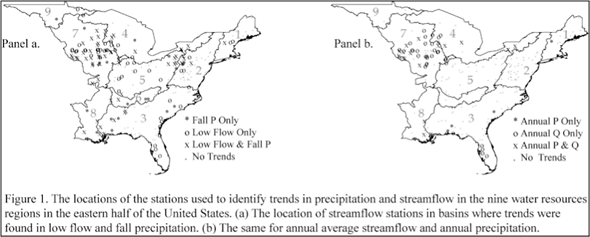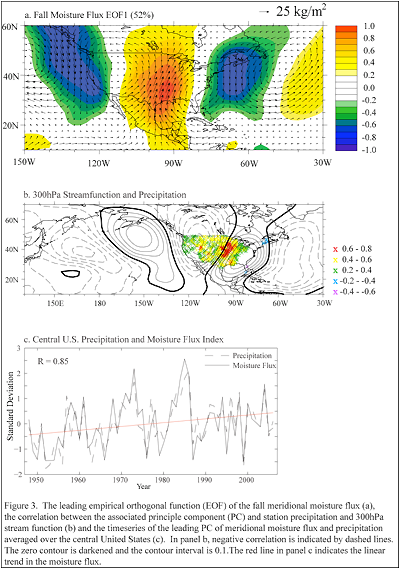A Diagnostic Study of Possible Enhancement of the Hydrologic Cycle
There is a broad consensus among climate models that a warming world will lead to a drier climate over most of the subtropical United States. Yet, observational evidence suggests that total precipitation and stream flow have increased across the United States over the last several decades with the largest increases generally observed in fall across the central United States. Identification of origins for the observed precipitation trends may be complicated by an apparent fall dry bias in current climate models. Most coupled climate models significantly underestimate precipitation over the Mississippi basin during fall, limiting our ability to skillfully predict future changes in precipitation or attribute the recently observed trends to anthropogenic origins. This apparent inconsistency between observed trends in fall precipitation and the dry bias in climate models is our motivation for trying to understand and identify the dominant mechanisms that produce trends and variations in fall precipitation.
What are our Goals, Objectives, and Hypotheses?
Several
recent studies have detected large increases in precipitation and
streamflow across the United States over the 20th century, with the
largest increases generally being reported in fall (September, October
and November) precipitation and low flow. Although the observed trends
in fall precipitation and low flow have been well documented, the
dominant forcing and mechanisms for fall precipitation have received
little attention. The key goal of this project is to understand the long-term trend and the decadal variability of fall precipitation over the central United States. To
achieve this goal, we focus on three primary questions: 1) What
mechanisms are important in producing the observed trends and decadal
variations in fall precipitation across the central United States and
how well are they represented in current generation climate models? 2)
Why are these mechanisms particularly important in fall and not other
seasons? 3) Can we identify physical linkages between decadal variations
in fall precipitation and Pacific or Atlantic SSTs?
Based on our
current research we hypothesize that the spatial coherence of the
observed trends and decadal variations in fall precipitation across the
central United States is largely controlled by the meridional transport
of moisture from the Gulf of Mexico. Dynamically, the precipitation
anomalies in the central United States are closely associated with
changes to regional-scale moisture transport that are, in turn, linked
to a hemispheric-scale wave pattern with an apparent origin in the
western tropical Pacific that is unique to fall. We hypothesize that
that this pattern of circulation anomalies is strongest in fall because
the position and strength of the jet streams are most favorable for a
strong mid-latitude response to forcing from the western Pacific during
the fall. We are currently investigating the apparent link between
circulation anomalies, enhanced moisture transports from the Gulf of
Mexico and modes of coupled SST and atmospheric variability in the
equatorial Pacific using observations and models.
What Do We Know About Precipitation Trends Across the United States?
Trends in Fall Precipitation and Low Flows (Small et al., 2006)
Many studies have reported that total precipitation is increasing across the United States, with many studies suggesting that most of the increase results from a positive trend in the upper tail of the daily precipitation distribution. Other studies have found that low and moderate, but not high- flows are also increasing across much of the United States. How can precipitation, especially that produced by intense events, increase without a corresponding increase in high flows? We analyzed trends in annual 7-day low, average and high flows along with seasonal precipitation that is averaged over individual basins. Our findings suggest that statistically significant trends in both fall precipitation and 7-day low flow are found in a large percentage of the basins in the upper Mississippi and Great Lakes regions of the country (Figure 1). A large fraction of the trends in annual precipitation can also be explained by an increase in fall precipitation. By estimating trends in precipitation at the spatial scale of individual basins, we offer a simple explanation for the apparent paradox of lack of trends in high flows. At the spatial scale of individual basins, precipitation is increasing during the fall but not during the other seasons when high flows are generally observed. The increase in fall precipitation appears to result in an increase in the low flows while the lack of trends in precipitation in other seasons explains the lack of widespread trends in the high flows.
Quasi-Decadal Variations in Fall Precipitation (Small and Islam, 2008)
Precipitation and streamflow have increased across the United States during the second half of the 20th century, with the largest increases observed in the fall. Our recent study (Small and Islam,2008) was the first to identify the quasi-decadal (QD) variability and link it to sea surface temperature anomalies in the western tropical Pacific. The QD signal in fall precipitation, with a period of approximately 12 years, is large and spatially correlated across most of the central United States. A weaker, much less spatially correlated secular trend signal, with a period greater than55 years, was observed that is strongest in the eastern United States. The QD signal increased in magnitude after 1950, the period when many previous studies have identified large linear trends in precipitation. Linear trends in fall precipitation are found to be more spatially consistent with the pattern of quasi-decadal variations than the secular variations (Figure 2), suggesting that increasing decadal variations in precipitation after 1950 have contributed to large linear trends in fall precipitation over the central United States.

The Role of Moisture Transport in Fall Precipitation Trends
The aforementioned study (Small and Islam 2008) suggests an important role for enhanced southerly moisture transport in the observed trend and decadal variability in fall precipitation. It is widely recognized that the dominant source of moisture for precipitation in the central United States is the Gulf of Mexico. Although the moisture flux is an important dynamical link between precipitation and circulation anomalies, few studies have examined the inter-annual variability of the mean moisture flux over the United States. To address this issue, we developed a simple index of the fall seasonal mean moisture flux that is strongly correlated to precipitation across the central United States and is able to explain the observed trend and decadal variability in fall precipitation over the region (Figure 3). The index was then used to link the southerly moisture flux over the central United States to a hemispheric-scale wave train and quasi-decadal scale variations in sea surface temperature (SST) anomalies in the western tropical Pacific. The results indicate that the leading mode of fall moisture transport over North America is independent of sea surface temperature anomalies in the eastern and central Pacific associated with ENSO. The analysis of the moisture flux was repeated for all four seasons to establish that the connection to the western tropical Pacific is only observed in fall. The results show that the dominant mode of moisture transport into the central United States in fall is unique, both in terms of the timescale of variability and remote origin. The connection to the western tropical Pacific, a region with rapidly increasing SSTs, likely explains why trends are only observed in the fall.
What Don’t We Know About Precipitation Trends Across the United States?
The question of why we only observe trends and quasi-decadal scale variability in precipitation over the United States in fall and not in the other seasons and whether we should expect this to continue in the future remains open. This is an important question because we believe the observed changes in fall precipitation are related to anomalous SSTs in the western tropical Pacific and Indian Ocean. This is precisely the region of the tropics where SSTs are expected to continue warming in the future. Our hypothesis is that only the fall background state of the atmosphere is favorable for a strong wave response over North America when the source (i.e. heating) is located in the western tropical Pacific or Indian Ocean. If this turns out to be the case, does this suggest that future trends in precipitation over North America should be largest in fall? Another important and open question is to quantify how well current climate models are able to capture the influence of a remote forcing on the transport of moisture over the continents. This question must be addressed before we can make informed decisions on how to respond to future climate change based on the output of climate system models.
What are our current findings?
Our current findings are summarized in the following selected publications, conference proceedings and presentations.
1. Publications
Small, D., S. Islam and M. Ting (2010a), Tropical Linkage to Trends in Fall
Hydroclimate over the United States, 1948 – 2006, submitted to Geophysical Research
Letters.
Small, D., S. Islam and M. Ting (2010b), Seasonal Differences in the Predominant
Modes of Moisture Transport over the United States, submitted to Journal of
Hydrometeorology.
D. Small and S. Islam (2009), A synoptic view of trends and decadal variations in autumn
precipitation across the United States from 1948 to 2004, J. Geophys. Res., 114, D10102,
doi:10.1029/2008JD011579.
D. Small and S. Islam (2008), Low frequency variability in fall precipitation across the
United States, Water Resour. Res., 44, W04426, doi:10.1029/2006WR005623.
Small, D., S. Islam, and R. M. Vogel (2006), Trends in precipitation and streamflow in
the eastern U.S.: Paradox or perception?, Geophys. Res. Lett., 33, L03403,
doi:10.1029/2005GL02499.
2. Presentations
Small, D L., Ting, M., and S. Islam (2009): The Impact of Large Scale Circulation
Anomalies on the Moisture Flux over the United States in Observations and Models, Eos
Trans. AGU, 90(52), Fall Meet. Suppl., Abstract GC33A-0713.
“Tropical Linkages to Trends and Decadal Variations in Fall Hydroclimate over the
United States 1948 – 2006.” Presented at MOCA-09 Joint Assembly, July 2009,
Montreal, QC, Canada.
“Tropical Linkages to Trends and Decadal Variations in Fall Hydroclimate over the
United States 1948 – 2006.” Presented at MOCA-09 Joint Assembly, July 2009,
Montreal, QC, Canada.
“A Synoptic View of Low Frequency Variability in Fall Precipitation Across the United States” Presented at the 2007 Joint Assembly, May 2007, Acapulco, Mexico.
“An Abrupt Rise of fall: Decadal Precipitation Variability in the United States after
1950”, Presented at the 2006 AGU Joint Assembly, 23-26 May 2006, Baltimore,
Maryland.
Who are working on this puzzle?
This collaborative project between the Tufts University and Columbia University builds on mutually synergistic expertise in water cycle research, atmospheric dynamics, and hydrology.
Who is sponsoring this research?
This collaborative project is currently sponsored by the National Science Foundation (NSF 0809783 and NSF 0811099).
This article appeared on the Tufts University website at https://sites.tufts.edu/shafikislam/ehc/
]]>

